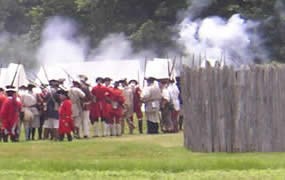Part of a series of articles titled French and Indian War - The Contest for the Ohio River Valley .
Previous: Jumonville Glen
Next: The Braddock Campaign
Article

Doug Fouser
Fortification and Reinforcements
After the skirmish with Jumonville's forces, Washington feared "we might be attacked by considerable forces."
He undertook to fortify his position at the Great Meadows. During the last two days of May and the first three days of June, he built a circular palisaded fort, which he called Fort Necessity.
In early June, Washington learned that Col. Joshua Fry died at Wills Creek on May 31. Washington was promoted to colonel and assumed command of the Virginia Regiment.
The rest of the Virginia regiment arrived at the Great Meadows on June 9, along with supplies and nine small cannon called swivel guns. Washington's command now totaled 293 officers and men. He was reinforced several days later by about 100 men of Capt. James Mackay's Independent Company of regular British troops from South Carolina. Washington's attempts to retain his Indian allies were not successful.
Advance and Retreat
While the South Carolinians remained at the Great Meadows, Washington and his Virginians spent most of June opening a road from Fort Necessity to Gist's Plantation, a frontier settlement in the direction of the forks of the Ohio. Reports that a large force of French and Indians was advancing from Fort Duquesne, however, caused him to withdraw his men to the Great Meadows, where they arrived July 1.
The Battle of the Great Meadows
The next day, they strengthened Fort Necessity by improving the trenches outside the stockade. On the morning of July 3, a force of about 600 French and 100 Indians approached the fort. After the French took up positions in the woods, Washington withdrew his men to the entrenchments. Rain fell throughout the day, flooding the marshy ground. Both sides suffered casualties, but the British losses were greater than French and Indian losses.
The fighting continued sporadically until about 8 p.m. Then Capt. Louis Coulon de Villiers, commander of the French force and brother of Jumonville, requested a truce to discuss the surrender of Washington's command.
Terms of Surrender
Near midnight, after several hours of negotiation, the terms were reduced to writing. Washington and Mackay signed the multi-part document. The British were allowed to withdraw with the honors of war, retaining their baggage and weapons, but having to surrender their swivel guns. Washington surrendered Fort Necessity to the French.
One clause stated that Washington was guilty of the assassination of a French officer, Jumonville. He denied this. He said the translation he had been given was not "assassination", but "death of" or "killing." In any event, the French used this propaganda to great advantage in efforts to discredit the English.
The British troops left Fort Necessity for Wills Creek on the morning of July 4. From there they marched back to Virginia. The French burned Fort Necessity and afterwards returned to Fort Duquesne.
The following year Washington joined another British expedition to the Forks of the Ohio under the command of General Edward Braddock.
Part of a series of articles titled French and Indian War - The Contest for the Ohio River Valley .
Previous: Jumonville Glen
Next: The Braddock Campaign
Last updated: November 5, 2020